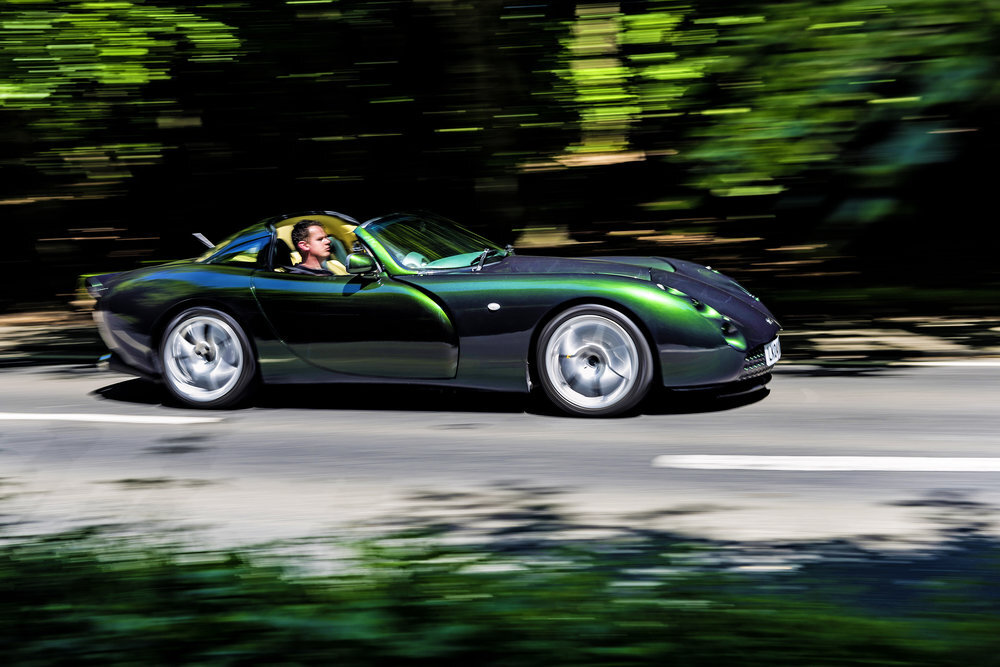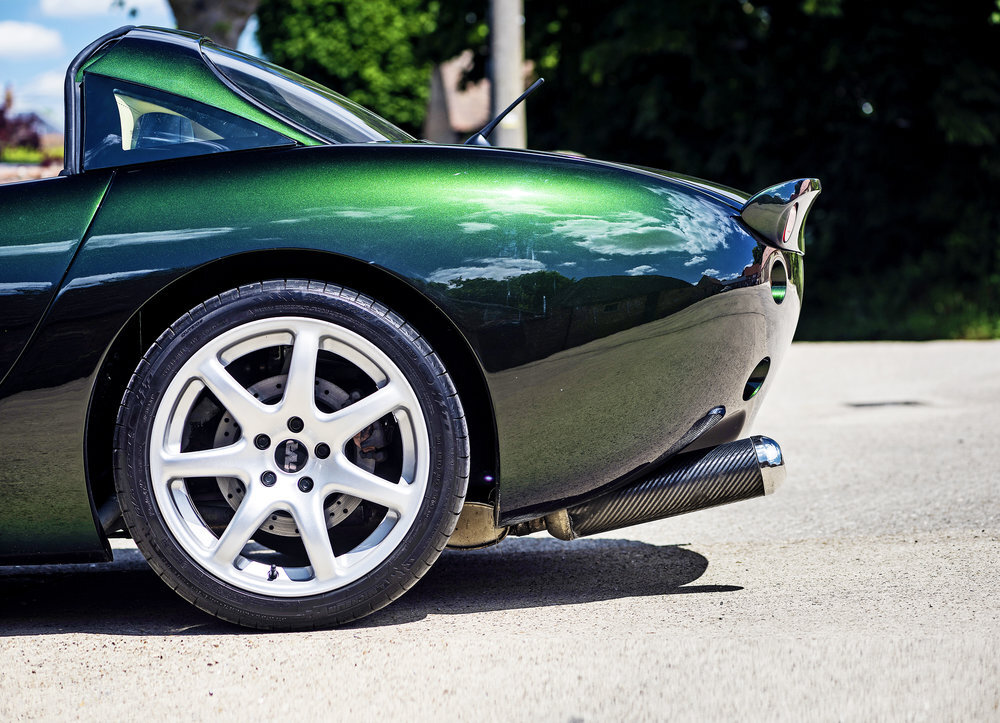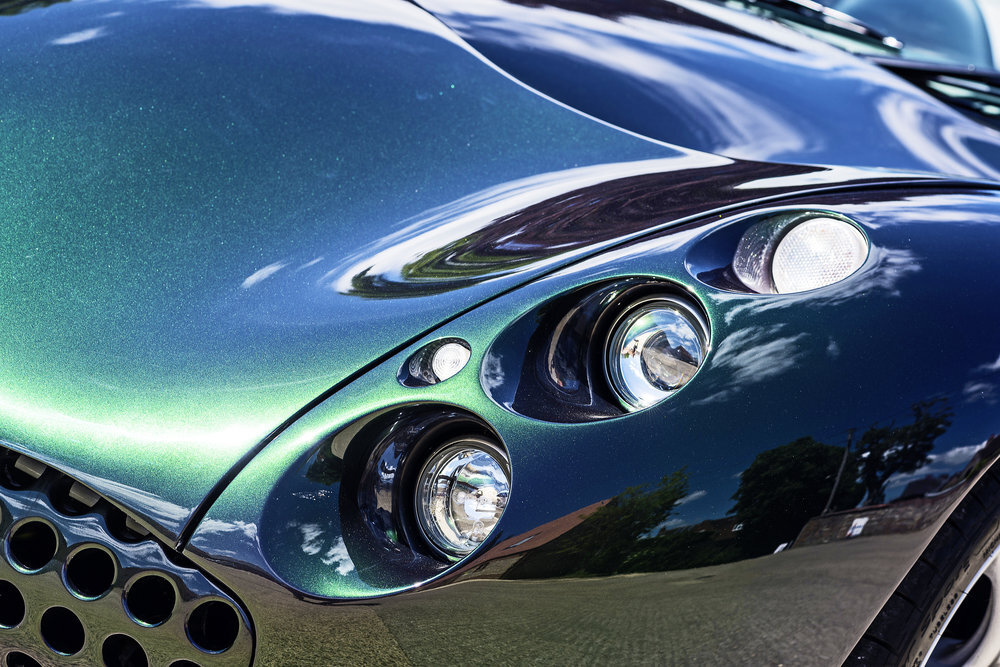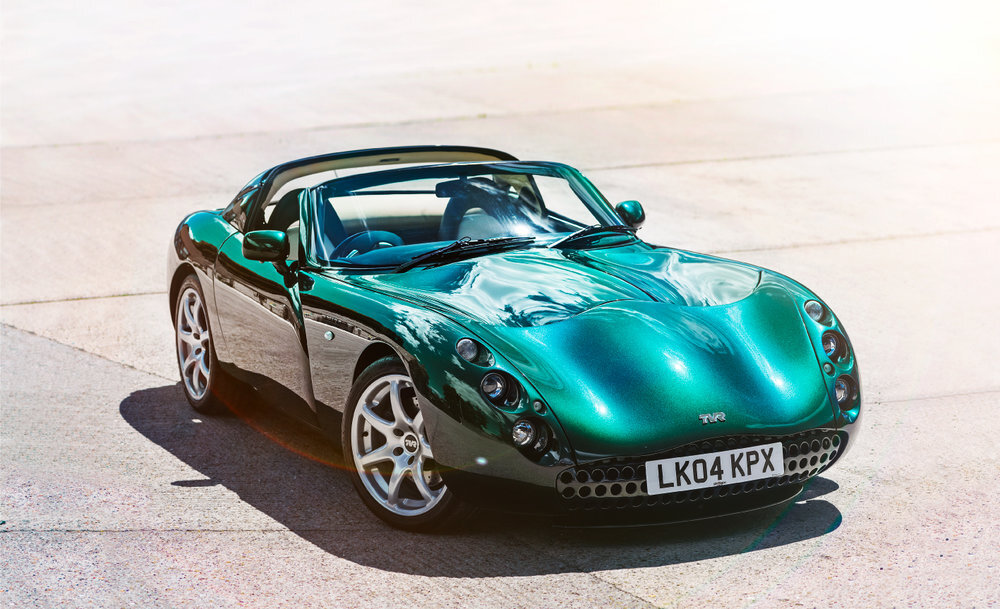The default dream car for many is a lipstick-red Ferrari or a lurid Lamborghini. But we reckon there’s not much that can beat a Tuscan S…
Words Dan Bevis Photography Chris Frosin
All this anxiety melts away as you ease yourself into the sumptuous cabin. The first thing you spot, of course, is that there are no door handles; the trick is to press the secret button under the wing mirror to pop the door open, then slide yourself down behind the chunky Nardi Personal steering wheel. Holy smoke, do TVR know how to do interiors! Just look at the thing – it’s bonkers. If you’ve ever had an absinthe-fuelled dream about lying in a verdant pasture with an antique clock while some benevolent soul pours melted Caramacs all over you, this Tuscan’s innards will seem peculiarly familiar to you. You find yourself cocooned in sumptuous creams and greens, a huge retro dial in front of you, hemmed in by a massive transmission tunnel studded with premium-feeling aluminium knobs and switches. The design hasn’t aged a day, it still feels über-fresh, and it’s this considered approach that instantly calms you down. This can’t be the terrifying, hairy-chested vandal that everyone makes it out to be. It feels like you’re lounging in one of those little fake living rooms in IKEA. Someone will probably be along with some meatballs in a moment. All is calm.
Calm, that is, until you fire up the Speed Six. Then the energy returns. You immediately step once more toward the precipice of terror. It’s worth pointing out that this particular car is no ordinary Tuscan S. It is, in fact, quite possibly the finest Tuscan S in the country. Lovingly curated by marque experts Str8six, it’s a low-mileage MkI finished in sensational Reflex Charcoal paint. They’ve hoiked out the motor and uprated the sprockets and bearings to tighten it all up, the interior’s been retrimmed in sumptuous new leather, and the nose has been repainted to eliminate those pesky stone-chips. The adjustable suspension has been optimised, it has fresh Michelins and it’s ready to rock. So… let’s do that.
A blip of the immobiliser button, then turn the key to the first click while the Tuscan self-checks. After a few seconds you’ll hear the fuel pump whirr, green-lighting you to twist the key further and fire the brawny six-pot into life. It catches instantly, settling into a calm but charged idle, crackling with potential energy.
The floor-hinged pedals are offset markedly to the right, your accelerator foot grazing the inner wing, so you find yourself pointing ever-so-slightly toward the front offside corner. But the snuggly seats (with lumbar support adjusted by a squeezy rubber bladder on a string) nestle you in so you’re totally at ease. Tasteful mirror adjustment buttons and rotary dials for the power windows are gloriously tactile. Thunk it into first, and brace yourself.
I’m under strict instructions to respect the car’s idiosyncrasies, not that I need telling twice. No more than 2500rpm is allowed until the oil temperature climbs above 60°. If the water temperature hits 100°, turn the damn thing off and chill out. So it’s with a certain degree of tippy-toeing that I pull out onto Oxfordshire’s winding country lanes. The targa roof panel’s out, I’m in a bona fide dream car, I’m happy to bumble. And by the time I eventually reach the first T-junction, everything’s up to temperature and ready to play.
This is just as well, as the Tuscan is immediately keen to remind me that there’s no traction control or anything lame like that. Exiting the junction on full lock with the tail wagging like an excitable labradoodle hammers home the fact that this isn’t a car designed to bumble. Perceptions realigned, I floor the throttle. What happens next is that bits of horizon which seemed tremendously far away are suddenly streaming past my wide eyes as the TVR thumbs its curvaceous Blackpool nose at the very fundamentals of physics. Holy hell, this thing is quick! I mean, quick enough off the line, but it’s at 4000rpm that it really comes alive, gargling like gravel and cream in a high-powered blender as the shift-lights flash and spur you on to the next ratio. The brakes, uncluttered by ABS, are staggeringly firm and immediate, allowing you to shear off vast swathes of vectors before exploiting the Tuscan’s trump card: its steering.
This car has many strengths – its mind-warping curves redefine the notion of automobile-as-art and the hefty gearbox is an utter joy to use – but it’s the quality of the steering that really defines the driving experience. Perfectly weighted, incredibly feelsome, it allows you to place the nose with millimetric precision at any corner angle, any speed. It’s so good it almost doesn’t seem real.
Naturally, there are two ways to steer this car. There’s a spinny wheel between your palms up front, but you can also steer with the two wheels at the back, and that’s a lot of fun too – the Tuscan S benefits from an LSD, and it’s always willing to let you slide the back end about at will. I’m enormously thankful that it didn’t rain on the day, as I’ve heard that can be a real crikey-I’m-in-a-ditch scenario, but on this hot morning it’s sticky tyres on bubbling tarmac. A visceral thrill at every turn.
Everything you’ve heard about the Speed Six motor is true. It’s hilarious, relentless, angry as a sealed jar of wasps in the sun. Kinda sounds like that, too. Part of the reason for that is the genesis of the Speed Six’s design; elements of the valvetrain can be traced back to superbikes of the early 1990s, and the individual throttle-bodies make it super-responsive – blip your right foot and it’s redlining in microseconds.
The crux of a TVR, as you’ve no doubt heard, is that it needs to be a bit tricky. These aren’t machines for people who want an easy time, they’re for those who want their effort to be rewarded, who accept that you get out what you put in. You need to be constantly on edge, worrying about the car – that’s part of the allure. I see the water temp gauge rising quickly past 90° as we cruise through Henley-on-Thames, so we head out to some open B-roads (negotiating the town’s speedbumps, no problem) and the car comes alive. But then another worry presents itself – working the Tuscan ever-harder down the lanes, a tremendous amount of heat starts to transmit through the gearstick, until the knob is almost too hot to touch. Which lends the act of changing gears a frisson of danger.
This isn’t a ‘worry’ at all. Not really. It’s character. It’s why people buy TVRs – they’re a bit mental, they’re not for people who care about fuel economy or being sensible. They’re for people who want to open the door by pressing a button on the dash, who want to pop their rear window out just for the sake of a breeze on the neck, who can’t abide choosing just one paint colour and want a car that’s four colours at once. On paper, the lack of electronic safety nets may seem risky, but in reality it’s all in keeping with the nature of an edgy car. The Tuscan S epitomises the concept of the driver’s car. It doesn’t need to be as silly as it is. But whoever daydreams about what they need?
The Modern Classics view
There are few cars that tick the dream-car boxes quite as comprehensively as Wheeler-era TVRs. Everything from the mind-warping, mushroom-infused, colour-shifting paint to the swooping, curvaceous, fairground-ride bodywork validates your every childhood notion that there really is no need to compromise. You can have it all. We all know the story of the Austin Allegro’s design, how it started out as something chic and rakish and was subject to so many management mandates and functional about-turns that it morphed into a total lame duck. Well, the Tuscan is the polar opposite of that way of thinking – a car engineered for staggering performance and hair-raising dynamics, with UFO-like aesthetics registering equally as importantly in those initial company brainstorms. It’s a car that never says no.
It makes for an intriguing proposition today, the 4.0 Tuscan S. While it’s indisputably in Modern Classics territory, it enjoys the unique hook of still looking and feeling entirely fresh and up-to-date. Wacky, outlandish styling is always a dangerous game, as it can make things age very quickly – see the Renault Avantime, Nissan Juke, Aston Martin Lagonda, it’s a long list – and it takes some time for the styling to come full circle and be regarded as cute again. But the Tuscan? The genius of its design is that it still looks brand new, and probably always will. It’s just so gorgeously weird. Hand a child a pack of crayons, say: ‘draw me a sports car,’ and they’ll sketch out a Tuscan. Say: ‘draw me a spaceship,’ and you’ll get the same result.
This is more than just a car, it’s the fulfilment of childhood dreams. At which point we can only reach the conclusion that, substantial wedge that it is, £40,000 is an alluringly low cost to make your dreams come true.
Specifications TVR Tuscan S
Engine: 3996cc/6-cyl/DOHC
Transmission: RWD, 6-speed manual
Power: 400bhp@7000rpm
Torque: 310lb-ft@5250rpm
Weight: 1100kg
Performance
0-60mph:3.8sec
Top speed: 195mph
Economy: 18mpg








